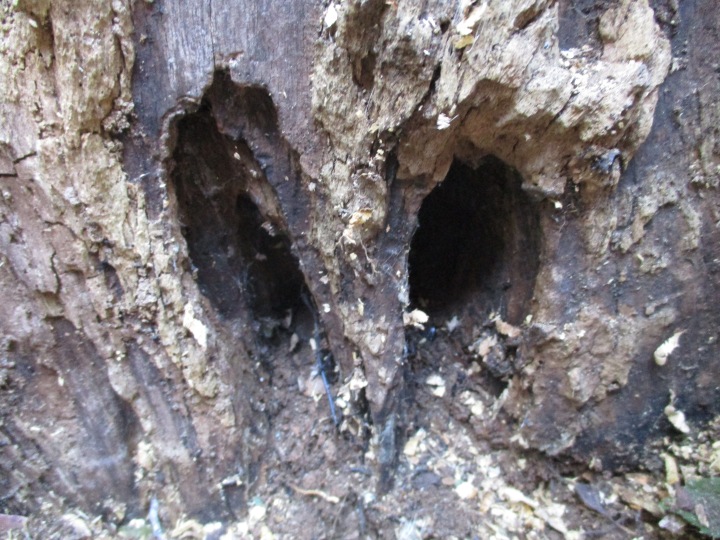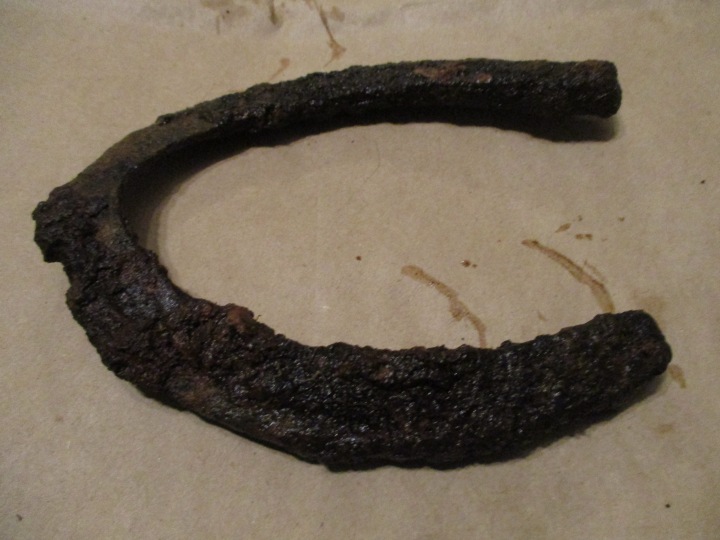Stumps are mostly left to rot after a tree gets cut down in our unrefined landscapes. Only those that are in the way get ground out. Some that remain probably would have been ground out if they were accessible to a stump grinder, because they are so unbecoming. Burning them out in winter is impractical for those that are close to buildings, and is no longer socially acceptable.
1. This one was nearly four feet high and nearly five feet wide! No one knows why it was not cut lower to grade. It was an unappealingly prominent feature of its landscape for several years.
2. Mushrooms around the base indicated that it was quite rotten. A lack of stubble or stumps from secondary growth indicated that the tree was likely dead before it was cut down years ago.
3. It was rotten enough to be inhabited by rodents. It looked like a duplex. Alternatively, the holes could have been excavated by skunks pursuing grubs. They did not seem to be very deep.
4. As big as it was, the stump was not quite big enough to become a hot tub as the rotten guts were removed. Besides, it was already an unsightly focal point without steam coming out of it.
5. What remains is a low pile of pulverized rotten wood with leaves from nearby dogwoods and a sweetgum tossed about on top to make it look less like a low pile of pulverized rotten wood.
6. There was a slice part way into the stump near grade, as if someone tried to cut it properly when the tree was cut down. This old bent horseshoe was found about where the slice stopped.
This is the link for Six on Saturday, for anyone else who would like to participate:
https://thepropagatorblog.wordpress.com/2017/09/18/six-on-saturday-a-participant-guide/
So number six is the answer to number one? Nothing unusual about hitting iron in tree stumps surely, fencing wire, gate hinge brackets. Don’t mix well with chain saws.
LikeLiked by 1 person
Well, I don’t really know. It was about where the cut stopped, and might have a a bit of a ding in it. (It is too rusted to know what is a ding and what isn’t.) It makes sense though. No arborist would have left such a big stump in such a prominent spot in a landscaped area without a good reason.
LikeLike
Wonder how old the horseshoe is?
LikeLiked by 1 person
I wonder what the horse was doing in a tree!
LikeLike
I agree with Jim… Cutting a tree that size must have been an incredible feat. Maybe they intended to cut the stump down farther but the horseshoe ended that idea. Just look at all the nice soft wood inside the stump to mix with potting soil or for mulch! 🙂
LikeLiked by 1 person
Any arborist capable of removing such a big tree so neatly from an established landscape would not have left such a big stump. The horseshoe just happened to be about where the cut stopped, and has a bit of a ding in it. I also suspect that it stopped the effort to remove the stump. Removing the stump was much easier for me because the interior was so rotten. I removed the pulp, and cut around the thin outer shell with a small chainsaw. It was like cutting thick cardboard. The rotten pulp was left there. We already have too much excellent compost. It seems like a waste, but I really did not want to move any more debris over the wall and down the stairs than necessary. I sort of want to plant something on the site to accelerate the decay of what remains below the surface, but there really is no need to. No one can see it.
LikeLiked by 1 person
I have noticed as years go by and the roots under the ground start to rot, a never ending sink hole starts to become a problem. I have one of those where an old Maple tree used to be.
LikeLiked by 1 person
I suspect that the process has already started here. I left a very slight pile of debris, but I sort of expect it to be at or even slightly below grade by spring. There is an unexplained low spot nearby that might be the result of the decay of another stump that was removed years ago. It is quite a bit area though.
LikeLiked by 1 person
What an enormous tree–and it appears to be growing beech mushrooms, which are yummy, but I’d double check, of course, before ingesting. That’s one thing to do with stumps. Seed them with mushroom spore of your choice.
LikeLiked by 1 person
We get a little bit of produce out of the landscapes at work, but I do not trust mushrooms. I believe that those are oak root rot, Armillaria mellea, which is the most prominently common mushroom here. It is also a honey fungus. I do not know what the other regional common names are.
LikeLiked by 1 person